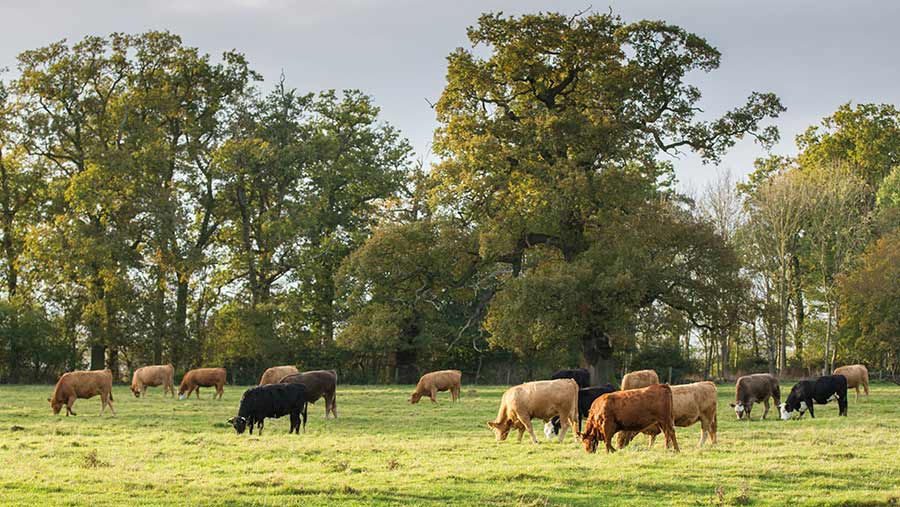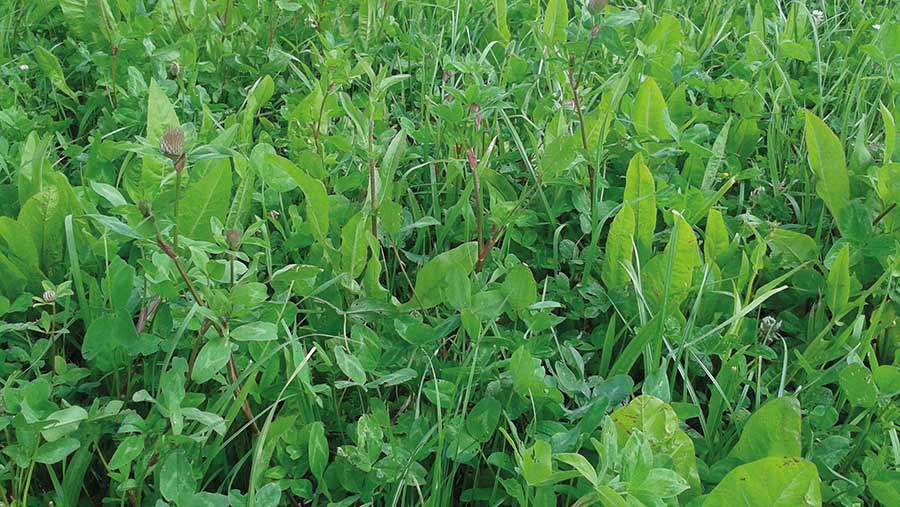How multispecies swards can improve production efficiency
 © Tim Scrivener
© Tim Scrivener Grassland in the UK has traditionally been dominated by ryegrass.
While ryegrass provides high yields of good-quality forage, it is dependent on applications of now-expensive nitrogen fertiliser and is susceptible to drought – leaving many farmers seeking out alternatives.
To examine the potential of alternative forages in more detail, a five-year study – funded by the Biotechnology and Biological Sciences Research Council’s Sustainable Agriculture Research and Innovation Club – investigated the feed value and environmental impact of multispecies swards compared with traditional ryegrass leys.
See also: Multispecies leys show seasonal advantage in Welsh uplands
The project was a collaborative effort involving the University of Reading as study lead, alongside partners Duchy College, Rothamsted Research North Wyke and Cotswold Seeds.
The aim was to achieve acceptable yields of good-quality forage for livestock production, while having a positive effect on the environment.

Multispecies sward © Chris Reynolds
It built on two previous external studies. The first, carried out by Teagasc, showed nitrogen-saving benefits and improved drought tolerance where multispecies mixtures were used.
The second, from the University of Dublin, looked at the health benefits – namely, reduced anthelmintic treatments – to sheep when fed multispecies swards.
Also, in an earlier Defra study carried out by the University of Reading, diverse forage mixtures showed a reduction in methane produced by dairy heifers, when grazed or fed as haylage.
Multispecies mixes
The latest study involved four treatment groups – a control mix of perennial ryegrass and three multispecies sward mixtures (see “Treatment groups for multispecies swards study”).
Treatment groups for multispecies swards study |
|||
|
Species |
Smartgrass |
Biomix |
Herbal |
|
Perennial ryegrass |
Y |
Y |
Y |
|
Timothy |
Y |
Y |
Y |
|
Red clover |
Y |
Y |
Y |
|
White clover |
Y |
Y |
Y |
|
Plantain |
Y |
Y |
Y |
|
Chicory |
Y |
Y |
Y |
|
Cocksfoot |
|
Y |
Y |
|
Festulolium |
|
Y |
Y |
|
Alsike clover |
|
Y |
Y |
|
Black medick |
|
Y |
|
|
Lucerne |
|
Y |
|
|
Meadow fescue |
|
Y |
Y |
|
Tall fescue |
|
|
Y |
|
Sweet clover |
|
|
Y |
|
Sainfoin |
|
|
Y |
|
Bird’s-foot trefoil |
|
|
Y |
|
Yarrow |
|
|
Y |
|
Burnet |
|
|
Y |
|
Sheep’s parsley |
|
|
Y |
The control plots received nitrogen at a rate of 250kg/ha a year, while all three multispecies swards received no nitrogen across the duration of the trial.
Multiple trial plots were sown at numerous locations across southern England and the project was split into several parts to look at different aspects of sward performance.
These included agronomic value, drought resilience, nitrogen cycling and emissions impact, and the value and use of multispecies swards on commercial farms.
In three-year trials looking at agronomic value, biomass yields were similar across the control and the multispecies plots in the second year of establishment, but greater for the multispecies plots in year three.
Grazing trial
In the grazing trial on the commercial farms, researchers observed growth rates of beef and dairy steers that were fed the different forage mixtures over two full grazing seasons.
Twenty 1ha paddocks were established, with five paddocks for each treatment group and 10 steers grazed on each of the different swards. The paddocks were strip-grazed, with daily fence movements.
Quadrat cuts were taken during the grazing season to estimate the biomass yield of each mixture. Forage height was also measured using a rising plate meter.
Detailed digestion measurements were also taken from 10 steers from each treatment over the two grazing seasons. Over five days, forage digestibility, nitrogen balance and methane emissions were recorded and analysed.
Liveweight gain
In the grazing trials, steers finished the 2018 season at about 400kg, with an average daily liveweight gain (DLWG) of 1.1kg.
There was no significant difference in growth rates observed when grazing the multispecies swards, though daily gain on the herbal mix was slightly higher, at 1.136kg a day, compared with 0.994kg for those fed the perennial ryegrass mixture.
In 2019, DLWG was 0.8kg a day and similarly, no significant differences were seen between the different treatment groups.
In terms of the digestion measurements, dry matter (DM) intake and DM digestibility were similar across the four treatment groups, though nitrogen digestibility was slightly higher for the control perennial ryegrass mixture.
Lower emissions
In the methane analysis, while the total emissions were similar across the four treatments – at about 160g a steer a day – methane emissions/kg DM consumed were lower for the multispecies treatments.
The fact that no nitrogen fertiliser was needed across all the multispecies treatments also offered an immediate saving in cost and emissions.
The nitrogen-fixing properties of the legumes included in these mixtures is also beneficial in reducing future nitrogen requirements.

Chris Reynolds © Chris Reynolds
Despite the positive results, the trial did not come without its challenges, explains project leader and professor of animal and dairy science at the University of Reading Chris Reynolds.
The biggest hurdle was dealing with seasonal variability of the multispecies swards, which affected maturity. Location and weather also resulted in variability in multispecies sward performance, he says.
Should you switch?
While the findings showed the benefits of using multispecies swards, Prof Reynolds says there are pros and cons that ought to be considered before switching from traditional ryegrass leys.
Pros:
- Multispecies swards are the “logical progression” from more traditional grass/clover leys
- Including legumes can reduce purchased nitrogen fertiliser requirement
- Multispecies swards have a proven yield benefit over monocultures
- Some species can increase drought tolerance
- Some species have animal health benefits, such as anthelmintic properties
- There is a reduction in emissions where multispecies swards are fed.
Cons:
- Performance can vary widely across different locations and landscapes
- There is still a lot more to learn about how best to establish and manage complex mixtures and their long-term benefits within systems.
Chris Reynolds was speaking at a recent conference on sustainable forages, hosted by the Society of Chemical Industry (SCI).
